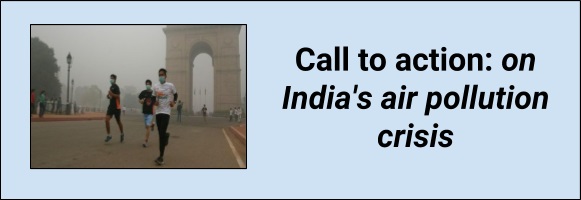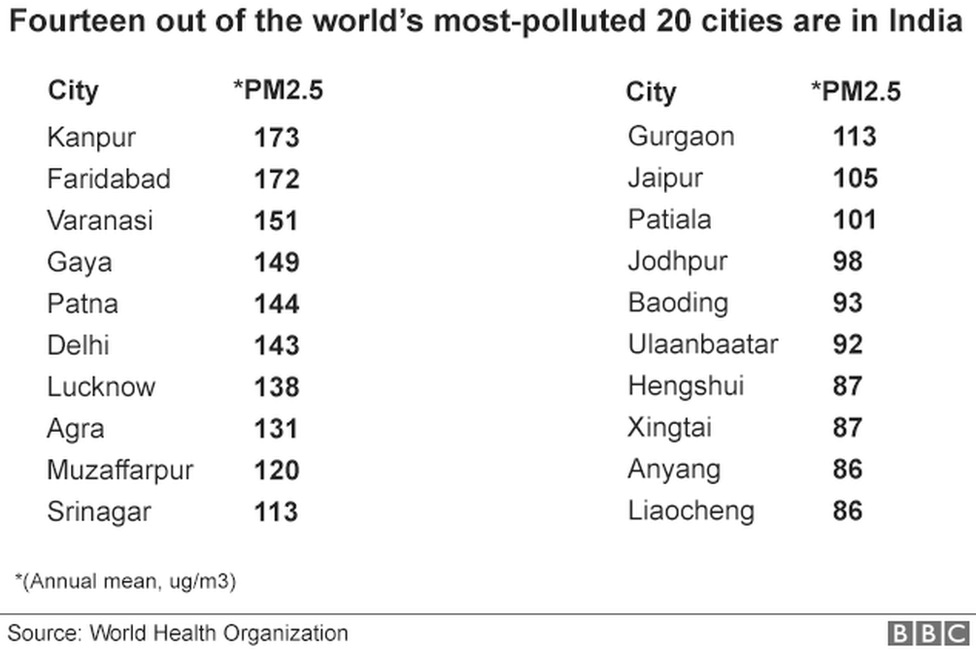NEW! The Gist (FREE) | E-BOOKS |
Call to action: on India's air pollution crisis : Important Topics for UPSC Exams

Call to action: on India's air pollution crisis : Important Topics for UPSC Exams
Why in News?
- Latest report released by WHO highlights the issue of widespread air pollution in urban India as well as deficient air quality monitoring.
About the Report
- The report, which summarised 2016 data for 4,300 cities, ranks 14 Indian cities among the 20 most polluted ones globally.
Poor Monitoring in Indian Cities
- Kanpur, Faridabad and several other pollution-choked cities have only one PM 2.5 monitoring station each, while Delhi has several.
- Out of the 5,000 odd cities and towns in India, monitoring is being done in only 307 cities moreover, most of this is manual monitoring that reports data with considerable time lag.
- WHO researchers get around this problem by using alternative data sources such as satellite remote sensing and chemical transport models, along with ground-monitoring stations.
Buy Printed Complete Study Materials for UPSC IAS PRELIMS Exam
Online Crash Course for UPSC PRE Exam
Findings of the WHO Report
- Air pollution is not a problem of large metropolises alone, even though they have traditionally been the focus of mitigation efforts.
- While Delhi comes in at number six, Kanpur, Faridabad, Varanasi, Gaya and Patna are ranked ahead of it, by PM 2.5 levels.
- Kanpur tops the list of world cities with the highest PM2.5 levels in 2016.
- Europe has the most extensive monitoring network, while countries in Africa and the Western Pacific region perform poorly. This means data from these regions are of poor quality, and likely underestimates, resulting in an under-count of the disease burden as well.
- Global death toll from air pollution at seven million a year, attributable to illnesses such as
- Lung cancer,
- Pneumonia and
- Ischemic heart disease.
- In 2016 alone, around 4.2 million people died owing to outdoor air pollution, while 3.8 million people succumbed to dirty cooking fuels such as wood and cow dung.
- About a third of these deaths occurred in Southeast Asian countries, which include India.
- Once monitoring improves in these regions, the numbers will likely be revised upwards.
- WHO mentioned that 9 out of 10 people in the world breathe air containing high levels of pollutants.
Blessing in disguise for India
- The report had words of praise for India’s Pradhan Mantri Ujjwala Yojana scheme, which has provided 37 million women living below the poverty line with LPG (liquefied petroleum gas) connections.
- Such schemes will also help cut the indoor air pollution that plagues much of rural India, which is not covered in the WHO analysis.

Air Pollution in Rural India
- It is important to remember, though, that rural India has problems beyond inefficient cook-stoves.
- As the recently published draft National Clean Air Programme noted, there are currently no air pollution monitoring stations in rural India.
- This does not mean outdoor air pollution is not a problem here.
- Studies have shown that ozone levels are higher in rural areas, as is pollution from insecticide use and crop-burning.
National Clean Air Programme (NCAP)
- NCAP has been formulated by environment ministry as a medium term National Level strategy to tackle the problem of Air Pollution across the country in a comprehensive manner.
- The plan sets itself three lofty objectives:
- Augmenting air quality monitoring mechanisms,
- Disseminating this information so that there can be greater public participation and
- Creating a ‘feasible’ action plan at a national level.
- The environment ministry has identified 100 non-attainment cities under National Clean Air Programme.
- NCAP misses three of the 14 of most polluted cities highlighted in the WHO’s latest report — Gaya, Patna and Muzaffarpur.
Way Forward
- The WHO has asked Southeast Asian countries to take swift action to tackle the twin problems of indoor and outdoor pollution.
- India needs -
- Massive energy transition across industries and households.
- Mobility transition to public transport, walking and cycling, and
- Effective waste management to control this run-away pollution.
- India must realise that its problems are larger than the WHO estimates, and take the call to action seriously.
MODEL QUESTIONS
Q. Which of the following statement is wrong about the findings of the latest WHO Report?
A. It ranks 14 Indian cities among the 20 most polluted ones globally.
B. Kanpur, Faridabad have multiple PM 2.5 monitoring stations.
C. About a third of these pollution related deaths occurred in Southeast Asian countries, which include India.
D. Report had praised India’s Pradhan Mantri Ujjwala Yojana.
Answer-B

